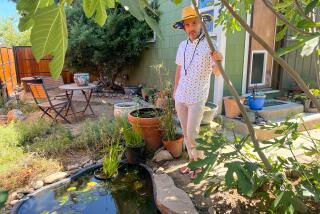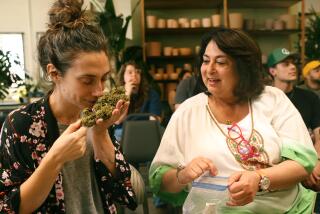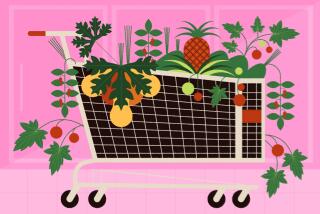Gardening : CONTAINER FARMING : No Vegetable Plot? Then Grow Them in a Pot
If you’d like to grow your own vegetables, but don’t have a patch of ground big enough or the time to spend tilling, hoeing, planting and irrigating, take heart--it’s very easy to grow an amazing variety of vegetables in pots indoors on your sunny windowsills and even easier to grow them in larger pots or tubs on a patio, deck, or porch.
According to Kathleen Bond-Borie, an avid indoor vegetable gardener and project manager for the Gardener’s Supply Co. of Burlington, Vt., the benefits of growing edibles in containers are many: you can grow food without a garden plot; you can extend the growing season for many vegetables and some can even be grown year-round; plants can be located close to your kitchen; and edibles in containers can be decorative as well as delicious.
Some of the vegetables that will thrive in a pot--as long as they gets lots of bright, bright sun, water, and plant food--are tomatoes, peppers, carrots, beets, lettuce, spinach, squash, cucumbers and onions. And besides the old standby “garden varieties,” there are lots of new compact varieties especially bred for container growing. (See chart.)
Vegetable seeds are available year-round through seed catalogues and at most nurseries and garden centers, and during these summer months, plantlets are available as well. To start vegetables from seeds, follow the directions on the package. If you choose to begin with plantlets, simply transplant the seedlings from their small pots or flats into the larger containers you plan to use.
Among the easiest and most dependable vegetables to grow in containers are salad greens, which means you can grow your own mesclun, the hottest new item on the better supermarket shelves.
Mesclun, or as it’s sometimes labeled “gourmet salad mix,” is a combination of any number of baby lettuces and other salad greens, such as arugala, endive, radicchio, sorrel, and edible flowers such as nasturtiums and pansies.
Prices range up to $8 or $9 a pound for these mixtures when you buy them at the market, but you can grow them at home for just the price of the seeds and a bit of sterilized potting soil.
According to Bond-Borie, the keys to growing vegetables in containers are choosing the right container, proper growing mediums, proper watering, providing enough light, and fertilizing correctly.
“When choosing a container for your edibles,” says Bond-Borie, “the needs of your plants should be your primary guide. Certainly you want to get containers that appeal to you aesthetically, but some vegetables, such as carrots, need containers at least 12 inches deep whereas greens and radishes need only half that depth.
“And keep in mind your plant’s moisture requirements,” cautions Bond-Borie. “Plants in smaller containers will dry out faster than those in larger ones. If you find yourself watering more than once a day, your plant needs to be in a bigger pot.”
As for growing mediums, regular commercial potting mix with a bit of peat moss, perlite and vermiculite mixed in will afford good drainage, hold moisture, and provide nutrients, three things critical to success in flower-pot farming.
Vegetables in containers need lots of water, which can create a problem for us here in drought-stricken Southern California. But here are a couple of water-saving tips:
By collecting water from your shower and sink faucets while they’re going from cold to hot, presuming two shower uses and two sink uses each day, you can collect 40 gallons of clear water a week--enough to water 150 10-inch pots, 10 fruit trees in half-barrels, or 20 tomato plants!
It’s a good idea to let the water you’ve collected sit out at room temperature for 24 hours in order for the chlorine to evaporate. (Although you can use gray--that’s “used water” collected from baths, showers, and washing machines--on your indoor plants and outdoor ornamentals, do not use gray water on your vegetables.)
Another good way of conserving water is to mix some sort of polymer, such as Agrosoke or Solid H20, into your potting mix. Polymers absorb many times their weight in water and release the water gradually. And finally, says Bond-Borie, water your plants early in the day since vegetable plants take up most of their water during the daytime.
Feed regularly with a water-soluble fertilizer such as Miracle-Gro at about half-strength once a week. And Bond-Borie recommends an occasional foliar feeding, as many plants are able to take up fertilizer more rapidly and more efficiently through their leaves than through their roots.
Light is probably the most critical factor in flowerpot farming. If you expect to have success, you’ve got to provide your plants with at least 6 to 8 hours of sunlight every day. That means a southern or at least a southwestern exposure for best results. You can also grow your indoor edibles under artificial light. A full-spectrum grow light, such as the Vita-lite, is preferable to incandescent or fluorescent since it most nearly duplicates natural sunlight, says Bond-Borie.
Finally, she cautions that maintaining good air circulation is especially important when growing vegetables in containers. You can improve air circulation by spacing plants farther apart, by opening windows if the plants are indoors, and by using small fans to keep the air moving.
If you’re interested in obtaining the Gardener’s Supply Co.’s free catalogue, you can write to them at 128 Intervale Road, Burlington, Vt., 05401, or call their toll-free number: 1-800-548-4784.
And to learn more about growing vegetables in containers, indoors or out, there are several good books available on the subject, among them “The Contained Garden,” published by The Viking Press, the “Sunset Book on Container Gardening,” and “Container Vegetables, the Easy Way to Garden,” Texas Gardener Press, Waco, Tex.
Recommended Container Vegetables
Plant: Beets Suggested Varieties: Detroit Dark Red, Early Wonder, Burpee’s Golden Growing Tips: Plant any time indoors in sunny window. Avoid overcrowding. Plant: Brussels Sprouts Suggested Varieties: Jade Cross Hybrid, Long Island Improved Growing Tips: 2-3 plants per 5-gallon container. Remove tops of plants to force sprout development Plant: Carrots Suggested Varieties: Little Finger, Baby Finger, Spartan Bonus, Short N Sweet Growing Tips: 2 inches between plants. Use soil-less mix. Place plastic cover over container to improve germination. Plant: Eggplant Suggested Varieties: Slim Jim, Black Beauty, Long Tom, Thai Green Growing Tips: 1 plant per 12-18 inch pot. Hard to grow indoors, but will produce fruit at 65-70 degrees. Plant: Endive Suggested Varieties: Broadleaved Batavian, Salad King, Giant Green Curled Growing Tips: To improve flavor before harvesting, gather outer leaves and tie loosely with string for 2 weeks. Plant: Lettuce Suggested Varieties: Oak Leaf, Buttercrunch, Salad Bowl, Ruby, Bibb Growing Tips: Can grow indoors year-round in sunny window. Leaf varieties are easiest. Fertilize weekly. Shield from intense sun. Plant: Radishes Suggested Varieties: Cherry Belle, Scarlet Glove Growing Tips: Plant weekly for continuous harvest all summer. In fall, bring indoors under lights to extend harvest. Grows well with carrots, lettuce and beets in large planter. Plant: Onions Suggested Varieties: White Sweet Spanish, Southport, White Globe Growing Tips: Outside, plant onion sets 2 inches apart. Don’t let dry out. Indoors, grow under lights for 12 hours a day. Plant: Tomatoes Suggested Varieties: Standard size: Early Girl, Better Boy Dwarf: (Cherry types): Tiny Tim, Toy Boy Growing Tips: One plant of standard variety per 5 gallon container. Dwarf varieties can be planted in smaller pots or hanging baskets. All types need consistent watering. Chart courtesy of Gardener’s Supply Co.






